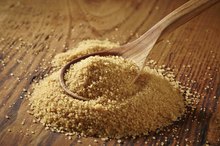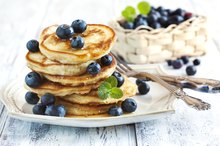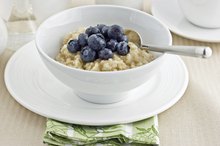What does fact checked mean?
At Healthfully, we strive to deliver objective content that is accurate and up-to-date. Our team periodically reviews articles in order to ensure content quality. The sources cited below consist of evidence from peer-reviewed journals, prominent medical organizations, academic associations, and government data.
The information contained on this site is for informational purposes only, and should not be used as a substitute for the advice of a professional health care provider. Please check with the appropriate physician regarding health questions and concerns. Although we strive to deliver accurate and up-to-date information, no guarantee to that effect is made.
Oats & Gout
Gout is a form of arthritis that develops when excess uric acid forms crystals in a single joint. Your symptoms, such as intense joint pain, swelling and redness, may come in sudden flareups known as gout attacks. Although various joints may be affected, the joint in your big toe is the most common, according to the University of Maryland Medical Center 1. In addition to medical treatment, healthy foods, including oats, may help manage your symptoms.
If you are experiencing serious medical symptoms, seek emergency treatment immediately.
Benefits
Dietary treatment for gout aims to prevent and manage high uric acid levels, which can trigger symptom flareups. The National Institute of Arthritis and Musculoskeletal and Skin Diseases recommends limiting foods that are high in natural substances called purines, which trigger uric acid production 2. As a fiber-rich food, oats promote appetite control and may ease the process of weight management, guarding against joint strain caused by excessive body weight. One half-cup of dry oatmeal provides 4 grams of fiber and 5 grams of protein. Oats also provide antioxidants, such as selenium. Antioxidants support your body's ability to resist and heal from infections and disease.
- Dietary treatment for gout aims to prevent and manage high uric acid levels, which can trigger symptom flareups.
Potential Risks
Bad Foods for Low Thyroid
Learn More
The UMMC recommends that people with gout avoid potential food allergens, including gluten -- a protein found in wheat, barley and rye. Although oats do not naturally contain gluten, commercial varieties are often contaminated with barley or wheat. The way you prepare oats can also enhance your wellness. Instant oatmeal, which is more processed and potentially less nutritious than old fashioned and steel-cut oats, should not be topped with brown sugar because it adds "empty" calories, or calories devoid of nutrients. Sugary foods may also offset your blood sugar levels, leading to appetite increases and weight gain. Preparing oats with whole milk adds considerable amounts of saturated fat and cholesterol, which may increase your risk for inflammation and heart disease.
- The UMMC recommends that people with gout avoid potential food allergens, including gluten -- a protein found in wheat, barley and rye.
- Preparing oats with whole milk adds considerable amounts of saturated fat and cholesterol, which may increase your risk for inflammation and heart disease.
Suggestions
For optimum nutritional benefits, choose old fashioned or steel-cut oats. Antioxidant-rich foods, particularly cherries, may help prevent gout attacks, according to the UMMC. For added antioxidants, top oats with cherries, blueberries, strawberries or raspberries. Low-fat milk may help lower your uric acid levels, so prepare oats with skim or low-fat milk instead of water or whole milk. Nutritious alternatives to brown sugar include stevia, which is a naturally sweet and antioxidant-rich herb, and pure maple syrup. If yeast-containing foods, such as wheat and white bread, worsen your symptoms choose oats instead.
- For optimum nutritional benefits, choose old fashioned or steel-cut oats.
- Low-fat milk may help lower your uric acid levels, so prepare oats with skim or low-fat milk instead of water or whole milk.
Other Helpful Foods
The Effects of Eating Meat on Arthritis
Learn More
To lower your uric acid levels, New York University Langone Medical Center recommends emphasizing plant-based protein, such as beans, lentils and tofu 13. Choose fresh fruits over juices, canned and dried fruit, which typically contain less fiber and high amounts of natural or artificial sugars. Other nutritious whole grains include brown rice, wild rice, pearled barley and air-popped popcorn. Rice and popcorn are gluten free. When purchasing breads, cereals and pasta, check nutritional labels to ensure that whole grains are listed as main ingredients.
- To lower your uric acid levels, New York University Langone Medical Center recommends emphasizing plant-based protein, such as beans, lentils and tofu 1.
Related Articles
References
- University of Maryland Medical Center: Gout
- National Institute of Arthritis and Musculoskeletal and Skin Diseases: Questions and Answers About Gout
- New York University Langone Medical Center: Low-Purine Diet
- USDA National Nutrient Database: Oats, Regular and Quick, Dry
- National Institute of Arthritis and Musculoskeletal and Skin Diseases. Gout. Updated April 2016.
- Zhang Y, Chen C, Choi H, et al. Purine-rich foods intake and recurrent gout attacks. Ann Rheum Dis. 2012; 71(9):1448-53. doi:10.1136/annrheumdis-2011-201215
- Fischer E. Ueber die Harnsauer. 1 [On Uric Acid. 1]. Berichte der Deutschen Chemischen Gesellschaft. 1884: 17:328-338. doi:10.1002/cber.18980310304
- Ragab, G., Elshahaly, M., & Bardin, T. (2017). Gout: An old disease in new perspective – A review. Journal of Advanced Research, 8(5), 495–511. doi:10.1016/j.jare.2017.04.008
- Centers for Disease Control and Prevention. Gout. Updated January 28, 2019.
- Zgaga, L., Theodoratou, E., Kyle, J., Farrington, S. M., Agakov, F., Tenesa, A., … Campbell, H. (2012). The Association of Dietary Intake of Purine-Rich Vegetables, Sugar-Sweetened Beverages and Dairy with Plasma Urate, in a Cross-Sectional Study. PLoS ONE, 7(6), e38123. doi:10.1371/journal.pone.0038123
- Choi HK, Gao X, Curhan G. Vitamin C intake and the risk of gout in men: a prospective study. Arch Intern Med. 2009;169(5):502–507. doi:10.1001/archinternmed.2008.606
- Zhang Y, Neogi T, Chen C, Chaisson C, Hunter DJ, Choi HK. Cherry consumption and decreased risk of recurrent gout attacks. Arthritis Rheum. 2012;64(12):4004–4011. doi:10.1002/art.34677
- Arthritis Foundation. Gout Diet: Dos and Don’ts.
- Boban M, Modun D. Uric acid and antioxidant effects of wine. Croat Med J. 2010;51(1):16–22. doi:10.3325/cmj.2010.51.16
- Caliceti C, Calabria D, Roda A, Cicero AFG. Fructose Intake, Serum Uric Acid, and Cardiometabolic Disorders: A Critical Review. Nutrients. 2017;9(4):395. Published 2017 Apr 18. doi:10.3390/nu9040395
- U.S. Department of Health and Human Services and U.S. Department of Agriculture. 2015–2020 Dietary Guidelines for Americans. 8th Edition. Published December 2015.
- U.S. Department of Health and Human Services. Gripped by Gout. NIH News in Health. Published February 2014.
- Kakutani-Hatayama M, Kadoya M, Okazaki H, et al. Nonpharmacological Management of Gout and Hyperuricemia: Hints for Better Lifestyle. Am J Lifestyle Med. 2015;11(4):321–329. Published 2015 Sep 2. doi:10.1177/1559827615601973
Writer Bio
August McLaughlin is a certified nutritionist and health writer with more than nine years of professional experience. Her work has been featured in various magazines such as "Healthy Aging," "CitySmart," "IAmThatGirl" and "ULM." She holds specializations in eating disorders, healthy weight management and sports nutrition. She is currently completing her second cookbook and Weight Limit—a series of body image/nutrition-related PSAs.









